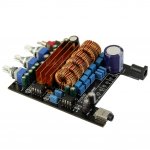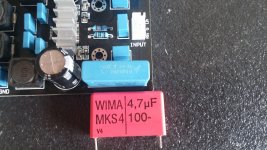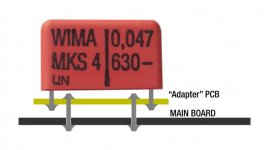Some info on 2.1 low pass filter from another forum:
Cheers
egra
Wow, getting a bit more complex then I'd like
On second thoughts, is there any reason I couldn't just place a passive filter between the sub out and the sub once I've measured how low my bookshelves go?
Some info on 2.1 low pass filter from another forum:
"I have one of the YJ 2.1 amps. I have been listening to it and testing it for about a month. I like it pretty well, but couldn't resist modifying it.
Stock form:
Left and right RCA inputs go direct to the two main channels through a 50k volume control and two 1uf caps in series (oddly one is film, the other is ceramic). The 'trible' control is just a high cut shelf filter with no boost (not even constant corner frequency), and I didn't find it very useful. The bass channel gets the sum of L+R after the volume control, then passes through a 72Hz -12dB/octave Salen-Key active filter, then a bass level control, before going to a buffer/inverter that allow it to get up to 100W rms into a 2 ohm (50W into a 4 ohm) subwoofer load.
In stock form, the distortion performance is reasonable (~.06%), but the low frequency rolloff is somewhat high at about 30 Hz.
It sounded pretty good to me until I made measurements and realized what I was missing at the bottom.
Microsurgery:
I replaced 6 small surface mount resistors and two SM capacitors with higher values to improve the low frequency response (noise is a non issue). Now it is about -1dB at 20Hz instead of -4dB to -6dB at 30Hz. It was decent before; it is really nice now.
I also cut three traces on the board, and rewired the 'trible' pot into the Salen Key filter, so now I have variable low pass frequency from 35 Hz to 1400Hz. The other mod I did was add a closed circuit 3.5mm stereo jack to the back panel above RCAs between the low pass and the bass level control so that I can use either the internal crossover when nothing is plugged into the jack, or use the full range direct input to the sub and use my miniDSP for high pass to the mains and low pass to the sub."
I'm using Clarion car LS set. 4" widerange satellite speakers and 12" sub. The satellite speakers are in an open baffle cabinet.
Cheers
egra
This is really good stuff, can you please elaborate more with pictures or diagrams? I have this amp labeled "Trible" too and the freq doesn't move worth beans. Did they just mis-wire it?
16V is a common value for caps, thats why. If you have a look into the specs right from the beginning, you'll see the voltages for GVDD etc.
They state to have 1uF at given voltage. But because the commonly known dc-bias of class-2 ceramics, you have to make sure to meet that requirement.
Depending on the dc-bias of your choosen cap, you may run in trouble because i.e. some 16V rated caps will have -40% at 7.5V while others only have -20% and are rated just 10V.
Thats why i recommend Murata or TY, as they offer "good" dc-bias vs. capacitance vs. case-size.
Ceramic Capacitors FAQ | Murata Manufacturing Co., Ltd.
Aye. Funny to me how this dcbias stuff supports superiority of tantalum's alongside aluminium's, yet so many dismiss their use anywhere, except to weigh the bin down. They're as good as oscons!!! lol...
I mentioned larger than spec voltage as that is one of my starting points of selection, as is having larger physical size for capacitance (reason I detest smd).
Of course many other factors are considered, I think I mentioned swamped in cap spec😱 sheets...
Yes, but you can get less capacitance at a given voltage from higher rated voltage due to bias (Dependsing on ceramics).
So starting from higher voltage is not always best.
Beside this, the larger the size, the larger usually the microphonics (due to piezoelectric effects).
So starting from higher voltage is not always best.
Beside this, the larger the size, the larger usually the microphonics (due to piezoelectric effects).
This is really good stuff, can you please elaborate more with pictures or diagrams? I have this amp labeled "Trible" too and the freq doesn't move worth beans. Did they just mis-wire it?
Hi xrk971!
I have not enough technical knowledge and instruments to answer Your question. The text what I quoted you can find here:
Opinions regarding Ebay YuanJing 2.1 amplifier board. Anybody tried it? - Page 2
I tuned my 2.1 system pretty empirically (by ears). The open baffle cabinet is rather simple to easy modification.
New 2.1 board on ebay:
TPA3116 High Power 2 1 HiFi Digital Subwoofer Amplifier Verst Board 2X50W 100W | eBay
In description found:
Advantages:
- Left and right channel full-range output, Can drive a 3-16 ohm speakers In the condition of rated voltage 24V,a very wide range
- The subwoofer channel at rated voltage 24V state can drive 2-16 ohm subwoofer, unique
- Bass cutoff frequency independent regulation 20HZ-20KHZ adjustable
- Independently adjustable subwoofer gain
Regards
egra
Attachments
Hi xrk971!
I have not enough technical knowledge and instruments to answer Your question. The text what I quoted you can find here:
Opinions regarding Ebay YuanJing 2.1 amplifier board. Anybody tried it? - Page 2
I tuned my 2.1 system pretty empirically (by ears). The open baffle cabinet is rather simple to easy modification.
New 2.1 board on ebay:
TPA3116 High Power 2 1 HiFi Digital Subwoofer Amplifier Verst Board 2X50W 100W | eBay
In description found:
Advantages:
- Left and right channel full-range output, Can drive a 3-16 ohm speakers In the condition of rated voltage 24V,a very wide range
- The subwoofer channel at rated voltage 24V state can drive 2-16 ohm subwoofer, unique
- Bass cutoff frequency independent regulation 20HZ-20KHZ adjustable
- Independently adjustable subwoofer gain
Regards
egra
I think I'm going to give this one a shot and hope for the best
Asimple technical question for people that are better with electronics than myself.
See image. The new caps are a lot bigger than the originals. So: twist them legs or go over the edge of the pcb with one leg and prolong it to the "terminal"?
The most elegant implementation is the "adaptor" as You can see on the attached image. IMHO.
PS: I ordered similar board last week, I'm curious about the result with red WIMA's.
Regards
egra
Attachments
Last edited:
Yes, but you can get less capacitance at a given voltage from higher rated voltage due to bias (Dependsing on ceramics).
So starting from higher voltage is not always best.
Beside this, the larger the size, the larger usually the microphonics (due to piezoelectric effects).
Next you'll be telling me the world is actually round, and not flat. Despite what I see before me! 😉 lol.
My methods aren't "technically accurate" but they work. As I mentioned in another post, "research, absorb, decifer, judgement, decide"... All leads to personal choice, and preference. Not all one and the same.
Last edited:
The following link may help anyone that both mine, and drmod posts have confused.....
Temp and voltage variation of ceramic caps, or why your 4.7-uF part becomes 0.33 uF | EDN
As I said drmod, and in true Yoda style.... "piles of cap spec sheets do I go through".
Although my method of choosing larger physical size per capacitance isn't from this info, it seems to agree somewhat.
And as a very highly respected audio manufacturer and Polish electrical engineer discovered, voltage is pretty irrelevant except for meeting minimum requirements.
A good general rule is cap V should meet voltage before cap+voltage after cap+voltage losses within cap " connection". Pretty much same as using tantalum's.... Must be 2Xrequired voltage, but should add 50% of V as tantalum's capable of losing large Voltage!!!
I do like the theory of DC bias in capacitors, as it argues against miniturisation of passive components!!! 😀
Temp and voltage variation of ceramic caps, or why your 4.7-uF part becomes 0.33 uF | EDN
As I said drmod, and in true Yoda style.... "piles of cap spec sheets do I go through".
Although my method of choosing larger physical size per capacitance isn't from this info, it seems to agree somewhat.
And as a very highly respected audio manufacturer and Polish electrical engineer discovered, voltage is pretty irrelevant except for meeting minimum requirements.
A good general rule is cap V should meet voltage before cap+voltage after cap+voltage losses within cap " connection". Pretty much same as using tantalum's.... Must be 2Xrequired voltage, but should add 50% of V as tantalum's capable of losing large Voltage!!!
I do like the theory of DC bias in capacitors, as it argues against miniturisation of passive components!!! 😀
The most elegant implementation is the "adaptor" as You can see on the attached image. IMHO.
PS: I ordered similar board last week, I'm curious about the result with red WIMA's.
Regards
egra
Elegant yes but adds a part you have to build/buy? Just bend the pins and keep the signal path simple. If too short, solder on extension pins from discarded pin clippings.
Yep. Voltage ratings on a MLCC mean "above this value, dielectric breakdown is possible" and nothing else.The following link may help anyone that both mine, and drmod posts have confused.....
Temp and voltage variation of ceramic caps, or why your 4.7-uF part becomes 0.33 uF | EDN
My Wiener card has two 4.7uF/50V X7R decoupling caps handling TPA decoupling, they're 1210 package and close to 3mm tall. Capacitance for those is still above 4uF with 24V bias.
I can also buy a 10uF/50V X5R cap in a 1.6mm high 1206 for far less money. You'd think that since I'm only running the part at half its voltage rating and it's got twice as many uF's to start with, it should work just as well, right? 😉
I just bent the damn legs🙂 Everything came out allright. Can't judge the sound yet, because im having so e oroblems with volume pot. It is an Alps 50k -http://www.aliexpress.com/item/NEW-1pcs-Japan-ALPS-Volume-control-27-type-potentiometer-Dual-50K-Round-shaft/1858501633.html
Dont know if it's authentic, but it costed almost as much as the amp😛
What is bothering me is the hum i'm getting with it. No matter which poin I try to properly ground, when my hand approaches the pot, I get a buzzing sound.
Connections i made (the pot has 1 2 3 labeled on its side):
1 all the grounds together. From raspberrypi to leftand right and then to the amp.
2 inputs. Raspi's left and tight
3 to the amp
Possibility of sth wrong? Maybe something else i should check out ?
Before this board I had a yired which had no grounding issues (if this is what's happening) and was silent like a grave.
Dont know if it's authentic, but it costed almost as much as the amp😛
What is bothering me is the hum i'm getting with it. No matter which poin I try to properly ground, when my hand approaches the pot, I get a buzzing sound.
Connections i made (the pot has 1 2 3 labeled on its side):
1 all the grounds together. From raspberrypi to leftand right and then to the amp.
2 inputs. Raspi's left and tight
3 to the amp
Possibility of sth wrong? Maybe something else i should check out ?
Before this board I had a yired which had no grounding issues (if this is what's happening) and was silent like a grave.
My Wiener card has two 4.7uF/50V X7R decoupling caps handling TPA decoupling, they're 1210 package and close to 3mm tall. Capacitance for those is still above 4uF with 24V bias.
I can also buy a 10uF/50V X5R cap in a 1.6mm high 1206 for far less money. You'd think that since I'm only running the part at half its voltage rating and it's got twice as many uF's to start with, it should work just as well, right? 😉
Nope. Smaller package with different dialectic. Wouldn't matter if max V is same. The V rating here is irrelevant as twice needed i.e V before + V after.
Decoupling slightly different in V requirement of cap than bypass, but using same rule neither improves, nor degrades.
With mlcc there is also question of how many layers in any given cap. More layers in same size cap means thinner dialectic between each layer.
Last edited:
That obviously applies to monolithic more than multilayer.
I would personally always chose the monolithic of any given value of cap, rather than multilayer of same value. My choice is down to dialectic thickness. Usually, creating a larger size cap for given value.
The other advantage of monolithic is smaller total surface area of dialectic/dialectic coating. =internal capacitance rather than =surface capacitance.
Very similar improvement that we would see between solid resistors compared to film/wirewounds. Solid = less surface area. And solids =less inductance etc. =my use of Allen Bradley or Arcol solid carbon composites.
But, as before, I push the right to personal preference. Nobody has to agree, nobody has to disagree.
I would personally always chose the monolithic of any given value of cap, rather than multilayer of same value. My choice is down to dialectic thickness. Usually, creating a larger size cap for given value.
The other advantage of monolithic is smaller total surface area of dialectic/dialectic coating. =internal capacitance rather than =surface capacitance.
Very similar improvement that we would see between solid resistors compared to film/wirewounds. Solid = less surface area. And solids =less inductance etc. =my use of Allen Bradley or Arcol solid carbon composites.
But, as before, I push the right to personal preference. Nobody has to agree, nobody has to disagree.
Update: big red caps seem to be causing some problems. When i touch them, the buz gets worse. Plus, sound quality isnt quite what I expected. The yired was much better. Unless it gets better with use...
Update: big red caps seem to be causing some problems. When i touch them, the buz gets worse. Plus, sound quality isnt quite what I expected. The yired was much better. Unless it gets better with use...
That happens to my YJ blue/black (copy) when go near the blue input caps, but when I bypass those caps with others to test, the buzzing and noise disappears.
Mine can't be the cap connections as my way of bypassing to test is by soldering to the bottom of the input cap pins (haven't removed them as yet because waiting for replacements). So I presume my issue is the caps themselves..... Maybe same with yours.
Update2: Turning off my TV seems to cure quite a bit of this noise. (if the tv is off touching the big red does nothing), the board is picking up crap from "thin air" I guess. Even with the tv and fish tank pump off, the amp is still to loud. Louder than dead quiet red board, anyway. Is there a way of finding the cure now? Or should I just enclose it in an earthed metal enclosure?
Can't wait to figure out this noise, as this amp, modded as it is, sound A LOT better than the red one. But only when it's working at least partially properly.
Another problem: sounds like popping and crashing when playing just a bit louder, but still not loud. I'm feeding it 14V DC.
Can't wait to figure out this noise, as this amp, modded as it is, sound A LOT better than the red one. But only when it's working at least partially properly.
Another problem: sounds like popping and crashing when playing just a bit louder, but still not loud. I'm feeding it 14V DC.
Last edited:
- Home
- Amplifiers
- Class D
- TPA3116D2 Amp


